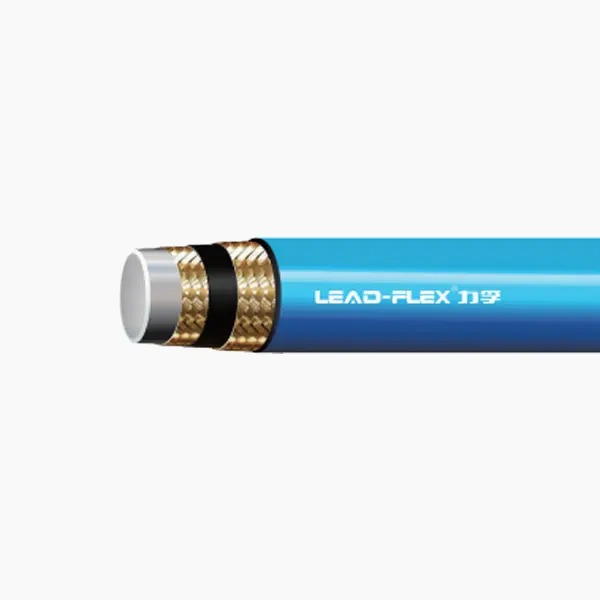Introduction
Steel wire braided hoses are essential components in a wide variety of industrial and hydraulic applications. Designed to withstand high pressure and harsh environmental conditions, these hoses are made by reinforcing a rubber or thermoplastic tube with one or more layers of braided steel wire. The primary objective of this reinforcement is to increase the hose's strength, flexibility, and resistance to internal pressure and mechanical stress.
Among the various types available, single braided and double braided steel wire hoses are the most common. They are often used in machinery, automotive systems, chemical processing, and heavy equipment. But what exactly sets these two types apart? Understanding the differences is crucial for engineers, procurement specialists, and technicians who want to ensure optimal performance and cost-effectiveness.
Let’s dive deeper into the structure, benefits, limitations, and appropriate use cases for both single and double braided steel wire hoses.
Structural Composition – Single vs. Double Braiding
How the Braiding Process Works
Braiding involves weaving high-tensile steel wires over a hose in a crisscross pattern. The process improves mechanical strength while retaining flexibility. For single braided hoses, one layer of braided wire is applied over the inner tube. For double braided hoses, a second braided layer is added over the first.
This difference may seem minor, but it significantly influences the hose’s pressure rating and flexibility.
Comparative Table of Structural Specifications
| Feature | Single Braided Hose | Double Braided Hose |
| Number of Wire Layers | 1 | 2 |
| Pressure Rating | Medium | High |
| Flexibility | Higher | Slightly lower |
| Outer Diameter | Thinner | Thicker |
| Weight | Lighter | Heavier |
| Cost | Lower | Higher |
As shown in the table above, double braided hoses offer more durability and strength due to the additional layer. However, they also come with trade-offs in flexibility, weight, and cost.
Pressure Performance and Application Suitability
Pressure Rating Differences
One of the most important factors when selecting a steel wire braided hose is pressure tolerance. Single braided hoses can handle moderate pressures, typically ranging from 1500 psi to 3000 psi depending on diameter and material. On the other hand, double braided hoses are designed for high-pressure systems, often rated between 4000 psi to 6000 psi or more.
This makes double braided hoses the go-to choice for hydraulic systems, drilling machinery, and applications involving sharp pressure surges. Single braided hoses, while less robust, are well-suited for air compressors, fuel lines, and general-purpose fluid conveyance.
Matching Applications with the Right Hose
Choosing the right type ensures not only system reliability but also cost efficiency and user safety.

Flexibility, Weight, and Handling Characteristics
Importance of Hose Flexibility
In installations where space is constrained or constant motion is involved, flexibility becomes a crucial factor. Single braided hoses have only one layer of reinforcement, making them more pliable and easier to bend. This enhances their usability in tight spaces or dynamic environments.
Conversely, double braided hoses are stiffer due to the extra layer of steel wire. This can be a disadvantage in mobile equipment or applications requiring frequent re-routing. However, their superior strength justifies the trade-off in many industrial settings.
Weighing the Hose’s Weight
Weight might not seem critical at first glance, but in large-scale systems or mobile machinery, the accumulated mass can affect performance and energy efficiency. Single braided hoses are lighter and easier to install or replace, particularly in overhead or remote areas.
Double braided hoses, while heavier, provide added security and durability, especially in high-risk environments where hose failure could result in severe damage or injury.
Durability and Service Life Expectations
Longevity Under Stress
Durability is a function of many variables—pressure, temperature, chemical compatibility, and frequency of movement. Double braided hoses usually outperform single braided ones in terms of service life under high-stress conditions. Their dual-layer design offers better protection against wear, external abrasion, and pressure-induced deformation.
However, for systems that don't operate under extreme conditions, the single braided hose can deliver reliable service without the extra cost of an additional steel wire layer.
Maintenance Considerations
Both types require regular inspection to identify signs of wear, corrosion, or fatigue. Double braided hoses might need less frequent replacement, but they are harder to maneuver and more expensive to replace. Single braided hoses are more manageable, which can reduce maintenance time and cost.

Frequently Asked Questions (FAQ)
Are double braided hoses always better than single braided ones?
Not necessarily. Double braided hoses offer higher pressure tolerance and durability but may be excessive for low to medium pressure applications. Choosing the right hose depends on the specific operational requirements.
Can I replace a single braided hose with a double braided one?
Yes, in most cases, as long as the connectors and pressure specifications match. However, ensure that the added stiffness and weight won't interfere with system performance.
What is the expected lifespan of each type?
Typically, single braided hoses last between 1 to 3 years in moderate conditions. Double braided hoses can last 3 to 5 years or longer, depending on use and maintenance.
How do I tell them apart just by looking?
Double braided hoses are generally thicker and heavier. If cut, you’ll also notice two distinct braided layers instead of one.
Conclusion
Selecting between single and double braided steel wire hoses is not just a technical decision—it’s a strategic one. Both offer unique advantages tailored to different use cases. If your system operates under moderate pressures and you value flexibility and cost-efficiency, a single braided hose is your best option. However, if your application involves high pressure, intense vibration, or exposure to harsh environments, a double braided hose provides the extra layer of confidence and durability.
Always consider the pressure requirements, spatial constraints, and cost implications before making your choice. Investing in the right hose type ensures longer service life, fewer breakdowns, and better overall system performance.














